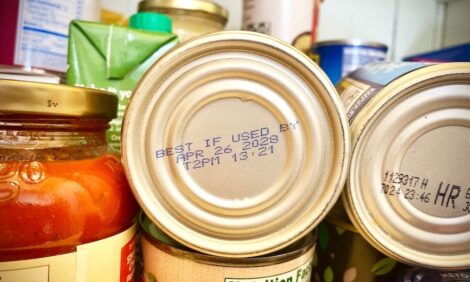



Determining US Milk Quality Using Bulk-Tank Somatic Cell Counts
Bulk tank somatic cell counts (BTSCCs) are indicative of the quality of the nation's milk supply. It appears that somatic cell counts (SCCs) are decreasing year by year, it appears that improvements in management practices and new EU import regulations may be responsible.The USDA’s Animal and Plant Health Inspection Service’s Centers for Epidemiology and Animal Health, in conjunction with USDA’s Agricultural Marketing Service (AMS) and the National Mastitis Council’s Milk Quality Monitoring Committee, monitor U.S. milk quality using bulk-tank somatic cell count (BTSCC) data provided by 4 of the Nation’s 10 Federal Milk Marketing Orders (FMOs') [figure. 1]. The remaining six FMOs do not collect BTSCC information.
Federal Milk Marketing Order Areas

BTSCC refers to the number of white blood cells
(primarily macrophages and leukocytes), secretory cells,
and squamous cells per milliliter of raw milk. BTSCCs
are used as a measure of milk quality and as indicators
of overall udder health. There is an inverse relationship
between BTSCCs and cheese yield and the
quality/shelf-life of pasteurized fluid milk. Numerous
studies have also shown that operations with increased
BTSCCs are more likely to have milk that violates
antibiotic residue standards. The most frequently
cited reason for antibiotic residues in milk is placing cows treated with antibiotics in the milking string before
the recommended withdrawal period.
To ensure high-quality dairy products, BTSCCs are
monitored in milk shipments using standards outlined in
the U.S. Pasteurized Milk Ordinance (PMO). In the
United States, the legal maximum BTSCC for Grade A
milk shipments is 750,000 cells/mL. If a producer has
two out of four shipments that test above the maximum
(usually tested 30 to 45 days apart) a written notice is
issued and an additional sample is tested within 21 days.
If three of the last five counts exceed the maximum,
regulatory action is required, which includes:
- suspension of the producer’s permit, or
- forego permit suspension, provided the milk in violation is not sold as Grade A, or
- impose monetary penalty in lieu of permit suspension, provided the milk in violation is not sold or offered for sale as Grade A product.
Maximum BTSCC levels for other countries include
400,000 cells/mL in the European Union (EU),
Australia, New Zealand, and Canada. The maximum
BTSCC level in Brazil is 1,000,000 cells/mLl.
Although there has been increasing support in the
last few years for lowering the maximum BTSCC for
Grade A milk in the United States to 400,000 cells/mL,
no changes have been made to the PMO. In May 2011,
the National Conference on Interstate Milk Shipments
(NCIMS) did not lower the U.S. limit, despite new EU
regulations for dairy products exported to the EU. These
new regulations were developed in cooperation with
AMS and went into effect in January 2012.
EU regulations are also centered on testing milk
from individual farms but require adherence to a 3-month
geometric mean BTSCC of less than 400,000 cells/mL.
EU member states have some latitude in formulating the
specific details of their individual programs.
U.S. producers that have four consecutive rolling
three-month SCC means greater than the 400,000
cells/mL limit cannot export milk to the EU unless
derogation** is requested and approved. If derogation is
not approved, the milk supplier must suspend, segregate
or discontinue certification.
In addition, the EU also has regulations on bacterial
standard plate counts. For these regulations, a 2-month
geometric mean is used based on a minimum of two
standard plate counts performed per month. The
bacterial limit for the EU is 100,000 cells/mL, which is
also the limit for Grade A milk in the United States;
however, the United States and the EU calculate
compliance differently.
Monitored FMOs
In 2011, four FMOs were monitored: Central, Mideast, Southwest, and Upper Midwest. These FMOs monitored milk from 29,937 producers located in 29 States and accounted for 91.2 billion pounds (46.5 percent) of the 196.2 billion pounds milk produced in the United States in 2011. Each of the 29 States marketed at least 1 shipment through the monitored FMOs during 2011 (figure 2).
Percentage of Total Milk Production Shipped Through Monitored FMOs in 2011, by State

In 2011, 324,465 milk shipments were monitored (table 1). The Upper Midwest FMO accounted for 46.5 percent of the milk monitored in the four FMOs and 21.6 percent of all milk produced in the United States. The Upper Midwest and Mideast FMOs had a higher percentage of shipments relative to the amount of monitored milk. The opposite was true for the Central and Southwest FMOs, in which 11.8 and 2.5 percent of shipments accounted for 16.9 and 17.5 percent of the monitored milk, respectively, which reflects the larger herd sizes in these two FMOs.
| Percentage of Milk and Shipments Marketed Through Monitored FMOs During 2011 | |||||
|---|---|---|---|---|---|
| Milk | Shipments | ||||
| FMO | Billion pounds | Pct. monitored | Pct. of U.S. production | Number (x1,000) | Pct. |
| Upper Midwest | 42.4 | 46.5 | 21.6 | 197.7 | 60.9 |
| Central | 15.4 | 16.9 | 7.8 | 38.3 | 11.8 |
| Mideast | 17.4 | 19.1 | 8.9 | 80.5 | 24.8 |
| Southwest | 16.0 | 17.5 | 8.2 | 8.0 | 2.5 |
| Total | 91.2 | 100.0 | 46.5 | 324.5 | 100.0 |
2011 BTSCC Trends
The milk-weighted geometric BTSCC mean in 2011 was 206,000 cells/mL compared with 224,000 cells/mL in 2010, a decrease of 18,000 cells/mL (figure 3). The milk-weighted BTSCC takes into account the amount of milk shipped by a producer, resulting in an overall BTSCC mean of monitored milk. The producer shipment BTSCC—which is a geometric, nonmilk-weighted mean of all shipments—decreased from 272,000 cells/mL in 2010 to 259,000 cells/mL in 2011.
Milk-Weighted and Producer BTSCC, 2006-11

Evaluating BTSCC Levels
More than 99 percent of milk and 98 percent of
shipments monitored met the current PMO limit of
750,000 cells/mL (table 2). Of the 29,937 producers,
92.3 percent (all but 2,305) shipped milk with BTSCCs
below 750,000 cells/mL during all months monitored.
In 2011, during all monitored months, BTSCCs in
92.7 percent of milk was less than 400,000 cells/mL.
Only 53.6 percent of producers shipped milk below this
limit for the entire year.
| Percentage of Milk, Shipments, and Producers by BTSCC Level During 2011 | |||
|---|---|---|---|
| BTSCC (x1,000 cells/mL) | Milk (91.2 billion lb) | Percent shipments (324,465) | Producers (29,937) |
| Less than 100 | 4.8 | 4.1 | 0.6 |
| Less than 200 | 47.7 | 30.3 | 11.2 |
| Less than 400 | 92.7 | 79.1 | 53.6 |
| Less than 650 | 99.3 | 96.7 | 86.4 |
| Less than 750 | 99.7 | 98.5 | 92.3 |
In 2011, almost 50 percent of shipments in all FMOs had BTSCCs between 200,000 and 399,000 cells/mL. The four FMOs had a similar percentage of shipments in each of the four BTSCC levels, although a higher percentage of shipments in the Mideast region were below 400,000 cells/mL (figure 4).
Percentage of Shipments, by FMO and by BTSCC Level, 2011

Based on the criteria for the EU Health Certification Program from USDA-AMS—which call for a 3-month geometric mean BTSCC of less than 400,000 cells/mL— 10 to 16 percent of U.S. shipments would have been noncompliant during 2011 (figure 5). These shipments represented only 3.3 to 5.5 percent of milk shipped during the monitored months.
Percentage of Shipments and Milk in 2011 that Would have been Noncompliant with the EU Health Certification Program’s BTSCC Criteria, by Month

FMO and State BTSCC Trends
Overall, BTSCCs have decreased every year since 2007 (figure 6) and, with the exception of the Southwest FMO in 2010, milk-weighted BTSCCs have decreased for each FMO since 2007. The Upper Midwest FMO had the highest BTSCCs during 2011 at 218,000 cells/mL, while the Southwest FMO had the lowest at 188,000 cells/mL. BTSCCs in the Southwest FMO decreased dramatically from 229,000 cells/mL in 2010 to 188,000 cells/mL in 2011.
Milk-Weighted BTSCCs by FMO and by Year

Fourteen States marketed 60 percent or more of the milk produced in their States through the monitored FMOs and accounted for 93.1 percent of the monitored milk in the four FMOs (table 3). Michigan, Minnesota, New Mexico, Texas, and Wisconsin accounted for 68.6 percent of all FMO-monitored milk. Overall, milk shipments in 2011 from monitored FMOs showed a downward trend in milk-weighted BTSCC levels. Thirteen of the 14 States had decreased BTSCCs in 2011 compared with 2010.
| Milk-Weighted BTSCCs for States Shipping 60 Percent or more of their Total Milk Production Through Monitored FMOs | |||||||
|---|---|---|---|---|---|---|---|
| BTSCC (x1,000) | |||||||
| State | Percent total monitored milk— 2011 | 2006 | 2007 | 2008 | 2009 | 2010 | 2011 |
| CO | 3.2 | 207 | 237 | 208 | 200 | 196 | 186 |
| IL | 1.8 | 282 | 272 | 262 | 260 | 258 | 241 |
| IN | 3.2 | 248 | 272 | 261 | 237 | 225 | 204 |
| IA | 7.2 | 269 | 282 | 281 | 252 | 241 | 228 |
| MI | 9.8 | 233 | 237 | 211 | 183 | 174 | 167 |
| MN | 10.0 | 261 | 270 | 266 | 249 | 236 | 227 |
| NE | 1.7 | 264 | 274 | 266 | 194 | 184 | 182 |
| NM | 10.0 | 217 | 236 | 216 | 196 | 207 | 167 |
| ND | 0.3 | 245 | 276 | 269 | 269 | 271 | 276 |
| OH | 4.5 | 270 | 267 | 253 | 225 | 226 | 220 |
| SD | 2.5 | 267 | 292 | 275 | 262 | 248 | 247 |
| TX | 10.0 | 258 | 285 | 254 | 239 | 253 | 208 |
| WI | 28.8 | 246 | 249 | 247 | 233 | 230 | 218 |
| WY | 0.1 | 234 | 335 | 356 | 196 | 139 | 127 |
| 14 States | 93.1 | 247 | 258 | 245 | 226 | 223 | 206 |
Seasonal BTSCC Trends
Monthly monitoring continues to show that BTSCCs peak during the summer months (July through September) when higher temperatures and humidity increase stress on cows and provide conditions more favorable for bacterial growth (figure. 7). In 2011, monthly milk-weighted BTSCCs were highest during August (243,000 cells/ml) and lowest in November (188,000 cells/mL). With the exception of December, BTSCCs were lower in all months during 2011 compared with 2010.
Milk-Weighted BTSCCs by Year and by Month, 2006–11

Summary
BTSCCs from monitored FMOs are indicative of the quality of the Nation’s milk supply. The overall BTSCCs from the four FMOs have decreased every year since 2007. Data from 2011 show a decrease of 18,000 cells/mL in the milk-weighted geometric mean BTSCCs compared with 2010. The BTSCCs for each of the four FMOs decreased between 2010 and 2011. Thirteen of the 14 States shipping 60 percent or more of their milk through the four FMOs had lower BTSCCs in 2011 than in 2010. In addition to improvements in management practices, the current EU import regulations may be partially responsible for the decrease in BTSCCs and the corresponding improvement in milk quality in 2011.
October 2012


